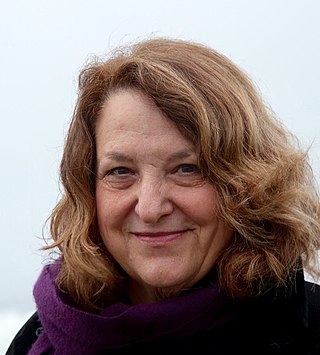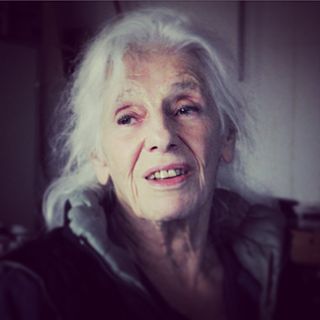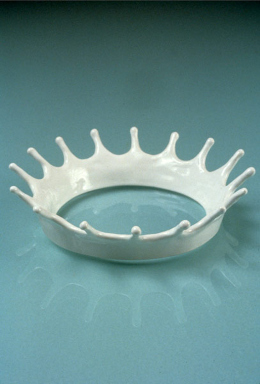
Janet Cardiff is a Canadian artist who works chiefly with sound and sound installations, often in collaboration with her husband and partner George Bures Miller. Cardiff first gained international recognition in the art world for her audio walks in 1995. She lives and works in British Columbia, Canada.

Barry McGee is an American artist. He is known for graffiti art, and a pioneer of the Mission School art movement. McGee is known by his monikers: Twist, Ray Fong, Bernon Vernon, and P.Kin.

Amy Sillman is a New York-based visual artist, known for process-based paintings that move between abstraction and figuration, and engage nontraditional media including animation, zines and installation. Her work draws upon art historical tropes, particularly postwar American gestural painting, as both influences and foils; she engages feminist critiques of the discourses of mastery, genius and power in order to introduce qualities such as humor, awkwardness, self-deprecation, affect and doubt into her practice. Profiles in The New York Times, ARTnews, Frieze, and Interview, characterize Sillman as championing "the relevance of painting" and "a reinvigorated mode of abstraction reclaiming the potency of active brushwork and visible gestures." Critic Phyllis Tuchman described Sillman as "an inventive abstractionist" whose "messy, multivalent, lively" art "reframes long-held notions regarding the look and emotional character of abstraction."

Lynn Hershman Leeson is an American multimedia artist and filmmaker. Her work with technology and in media-based practices is credited with helping to legitimize digital art forms. Her interests include feminism, race, surveillance, and artificial intelligence and identity theft through algorithms and data tracking.

Josephine Gail Baer was an American painter associated with minimalist art. She began exhibiting her work at the Fischbach Gallery, New York, and other venues for contemporary art in the mid-1960s. In the mid-1970s, she turned away from non-objective painting. After then, Baer fused images, symbols, words, and phrases in a non-narrative manner, a mode of expression she once termed "radical figuration." She lived and worked in Amsterdam, Netherlands.

Jessica Stockholder is a Canadian-American artist known for site-specific installation works and sculptures that are often described as "paintings in space." She came to prominence in the early 1990s with monumental works that challenged boundaries between artwork and display environment as well as between pictorial and physical experience. Her art often presents a "barrage" of bold colors, textures and everyday objects, incorporating floors, walls and ceilings and sometimes spilling out of exhibition sites. Critics suggest that her work is informed by diverse artistic traditions, including abstract expressionism, color field painting, minimalism and Pop art. Since her early career, they have noted in her work an openness to spontaneity, accident and marginality and a rejection of permanency, monetization and disciplinary conventions that Stephen Westfall characterized as an "almost shocking sense of freedom."
Molly Springfield is an American artist whose work includes labor-intensive drawings of printed texts and visual explorations of the history of information and mediated representation.

Bill Dane is a North American street photographer. Dane pioneered a way to subsidize his public by using photographic postcards. He has mailed over 50,000 of his pictures as photo-postcards since 1969. As of 2007, Dane's method for making his photographs available shifted from mailing photo-postcards to offering his entire body of work on the internet.

Ellen Harvey is an American-British conceptual artist known for her painting-based practice and site-specific works in installation, video, engraved mirrors, mosaic and glass. She frequently pairs traditional representational vocabularies and genres with seemingly antithetical postmodern strategies, such as institutional critique, appropriation, mapping and pastiche. Her work examines such themes as art as a mirror, interactions between built environment and landscape, ruins and the Picturesque aesthetic, and cultural and economic relationships between museums, artists and publics. Curator Henriette Huldisch writes of her work, "haunted as it is by the notion of art's ultimate futility, her paradoxical stake is in persistently testing art's possibility to do something in the world after all."

J. John Priola is a San Francisco-based contemporary visual artist and educator. He is known for photographic series capturing humble, generally inanimate subjects that explore human presence, absence and loss through visual metaphor. Priola's mature work can be broadly divided into earlier black-and-white, gelatin-silver series—formal elegant, painterly works largely focused on everyday objects and architectural details elevated to portraits—and later color series, which gradually shifted from architectural settings to detailed, varied explorations of the often-conflicted human relationship to nature. San Francisco Chronicle critic Kenneth Baker situated Priola's images "on the border between documentary and conceptual art," where they function as surveys of under-noticed details that "remind us how many potential questions, how much intimate domestic history, may lie embedded on the margins of our attention."

Jennifer Bolande is an American postconceptual artist. Her art explores affinities and shifts of meaning among sets of objects and images across different contexts and media including sculpture, photography, film and installation. She emerged in the early 1980s with work that expanded on ideas and strategies rooted in conceptualism, Pop, Arte Povera and the so-called Pictures Generation. Her work focuses on thresholds, liminal and peripheral spaces, and transitional moments—states she enacts by the repetition, accumulation and recontextualization of found materials. She frequently selects cultural artifacts on the verge of obsolescence or in flux—and thus acquiring new meanings—and archives, studies and reframes them. Artforum critic Paula Marincola wrote, "Bolande's highly individualized amalgam of sculpture and photography proceeds obliquely but precisely toward an accumulation of possible meanings. She is a connoisseur of unlikely but evocative details, of subliminally perceived, fragmentary images and events."

Patricia Anne Smith, known professionally as Alexis Smith, was an American visual artist. She worked in collage and installation.

Maria Porges is an American artist and writer based in the San Francisco Bay Area. As an artist she is known for the prominent use of text in her visual works, which encompass sculpture, works on paper and assemblage and have an epistemological bent. As a critic Porges has written for Artforum, Art in America, Sculpture and SquareCylinder, among other publications.
Cynthia Daignault is an American painter. Her work is often described as rigorous and intense. Daignault is also a writer and musician and curator. She lives and works in Brooklyn, New York.
Peggy Cyphers is an American painter, printmaker, professor, curator, and art writer. Cyphers was a formative figure in the East Village art scene during the 1980s, and has had her work exhibited in the United States and Europe since then.

Fraenkel Gallery is a contemporary art gallery in San Francisco founded by Jeffrey Fraenkel in 1979. Daphne Palmer is president of the gallery.
Jacci Den Hartog is an American sculptor.
Sarah Bostwick is an American artist, known for her architecture or landscape inspired, minimal, cast and carved drawings.

Pamela Helena Wilson is an American artist. She is best known for watercolor drawings and paintings derived from photographs, largely of news events, architectural forms and landscapes. Her journalistic sources frequently portray scenes of natural and human-made calamity and the conflict, devastation and reactions that follow, often involving teeming crowds and demonstrations. Wilson's process and visual editing obscure these events, translating the images into suggestive, new visual experiences with greater urgency, universality and an open-endedness that plays against expectations. In 2013, critic Michelle Grabner wrote, "The luminosity of watercolor on white paper and the alluring atmospheric effects [Wilson] achieves in this medium creates images that are neither photographic or illustrational but seductively abstract and representational."
Rebeca Bollinger is an American artist. She works with sculpture, photography, video, drawing, installation, writing and sound.













